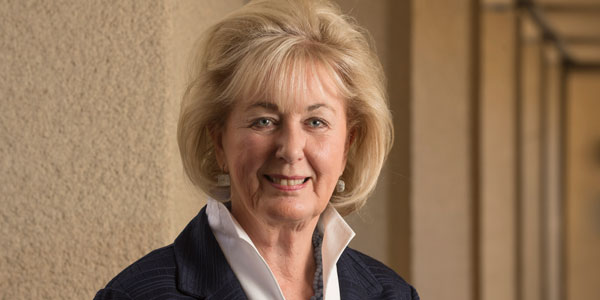

Carol Nevin Rundback does not measure her contributions to Cal Poly Pomona based on the dollar amount she gives. The value of her gifts come from the success of students who have received her work-study stipends and scholarships.
For instance, a master's degree candidate needed funding for a thesis project and received a work-study stipend to support her research. Another student, a mother, commuted from Inglewood five days a week to attend classes and received a stipend that helped pay for her studies.
"That's important — each one of these students are changing their families," said Rundback ('69, social sciences). "I really believe and see that Cal Poly Pomona is changing the education and economic landscape of California, and our philanthropy is fueling this engine of change."
In 2013, Rundback designated her estate to Cal Poly Pomona to award full, renewable scholarships in her name for the colleges of engineering, science and agriculture. Then in 2017, she discovered another way to give with a 70th birthday present for a college friend who owned a winery in Sonoma with his wife. He did not need anything, but she thought about Cal Poly Pomona's vineyards and reached out to the Huntley College of Agriculture on how to support students interested in pursuing a career in the wine industry. Her present to her lifelong friend ended up benefiting a Huntley College student, who gained valuable work experience.
"My friend was very touched by the gift I had given in his name, and I began to understand the challenges many students have to be at Cal Poly Pomona," Rundback said. "Financial support is a major issue for many students, and I have and will continue providing these stipends."
To Rundback, this is what people are supposed to do when they grow up.
She first learned about philanthropy as a child from her father's cousin, who she called Aunt Ruth, who told her family in the 1950s that she was giving her estate to the Navajo Nation. Ruth's goal was to provide at least two ambulances for the tribe who at the time had none.
When Ruth retired to the San Diego area, Rundback drove to visit her and they would go to Escondido to shop and pick up clothing and toys for Navaho children during Christmas. Each year, tribal elders would send Ruth a list of names, ages and sizes and she would fill her home and garage with presents for the elders to pick up before Christmas.
"We see these kinds of efforts everywhere now," Rundback said. "When Aunt Ruth passed in the 1980s, I learned her estate was in excess of $2 million, far more than the cost of two ambulances. I think she was smiling."
Ruth was more than a philanthropic inspiration. Rundback saw her aunt's life as encouragement that she could be and do anything she wanted.
After Ruth received her master's degree in art in Chicago, she lived in Paris for several years during the Roaring Twenties. She realized that although she created great art pieces, she felt that there were others who were more talented, and she returned to the United States to teach at a Midwest university. When the Great Depression affected artists' lives, Ruth acquired a small group of bungalows in the Glendale foothills. She invited artists to live there and it became a creative colony where residents supported each other through the difficult times. In the mid-40s, she moved to Los Angeles and spent the remainder of her career working with a ceramicist and managing an art studio. She never owned a car, television or radio, or even a telephone, and preferred to write letters.
It was in the 1950s that Rundback was drawn to the cover artwork of steamships and smokestacks on Ruth's copies of Fortune Magazine. The articles were links to the industrial world outside of her San Gabriel Valley community.
"Today, no one would blink at a woman or an artist reading this magazine, but back then it was very unlikely," Rundback said. "I grew up around Aunt Ruth never dreaming my life would lead me to do the same, but her example gave me courage to embrace opportunity."
Inspired by Ruth's life, Rundback navigated her way across the United States, living in all four corners of the country while working in three distinct careers. Once she retired and became widowed, she settled in Southern California, when she started giving back to Cal Poly Pomona and spending time on campus.
"Whenever I'm on campus I allow time for a bit of a walkabout, like President Coley does, often seeing something I haven't seen before as well as talking to people along the way," Rundback said. "It's impressive. One faculty member expressed it as a circle of contagious enthusiasm between the students and faculty."
Rundback is in awe of how much the campus has changed in its look and in the quality of experiential learning opportunities offered to students.
"Students face so many challenges today and they need help," Rundback said. "Whatever the students want to do in their life, they need to go for it and not be afraid. We have a new generation coming up and they're rather remarkable."